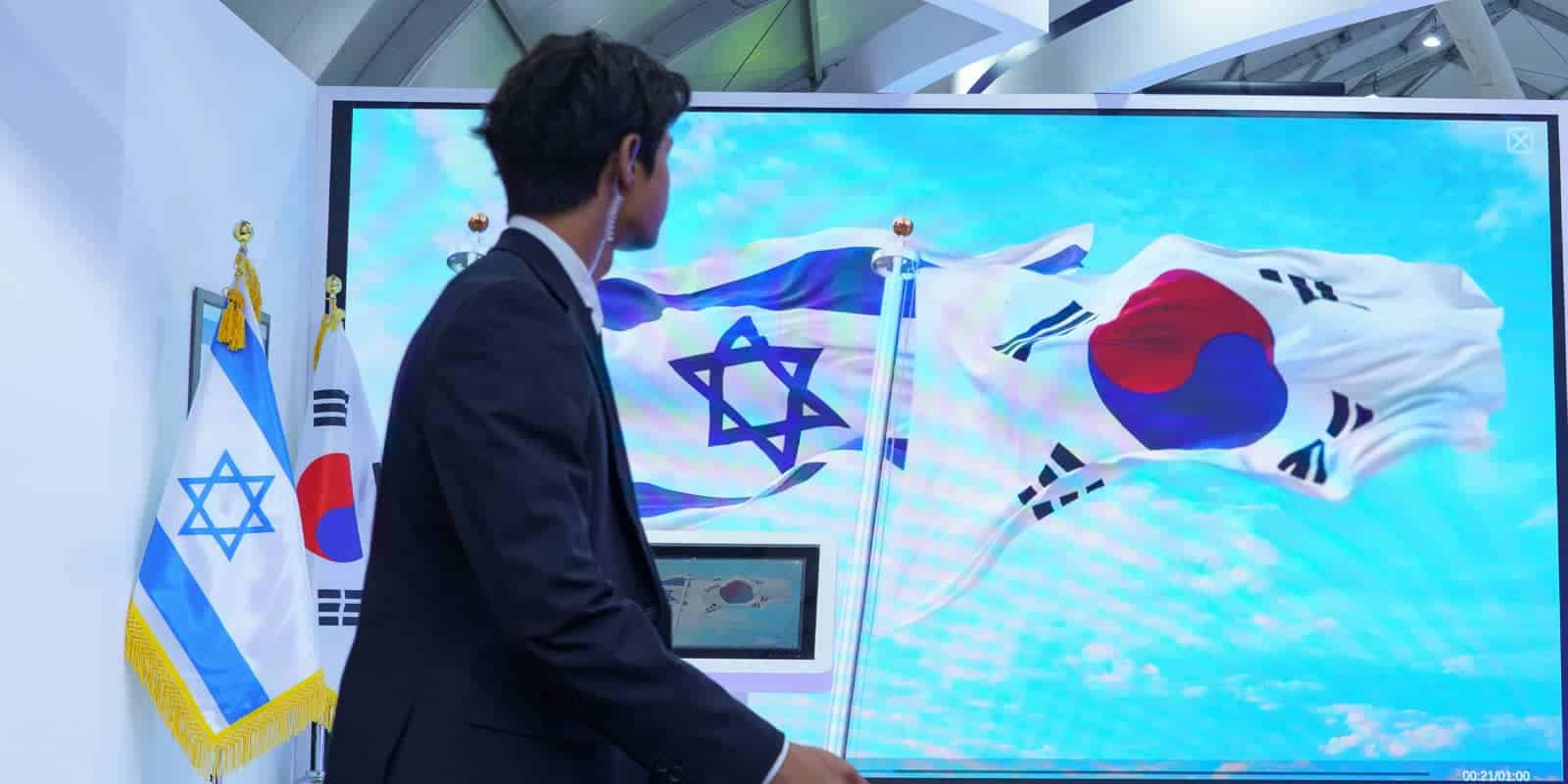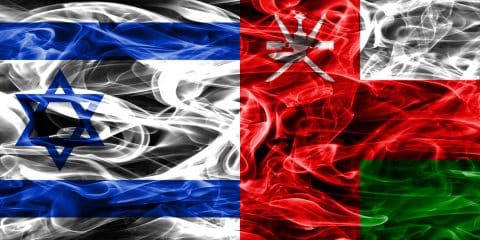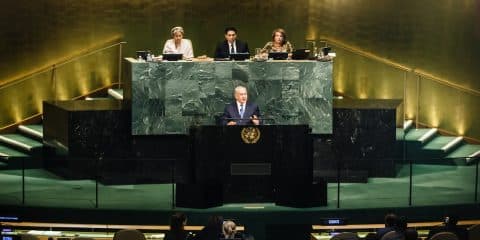The parallels between the predicament of Israel and the Republic of Korea are considerable. Both face existential threats on their borders. Though both states are democracies, the commonalities between them run deeper. Both are relatively young countries born out of conflict. Both exist under threats from their respective neighbors from inception. Both suffered periods of isolation in world politics,[1] yet despite heavy economic burdens due to many security challenges, both managed to build a vibrant democracy and a prosperous economy. Both countries maintain the most vital asset one can provide to the United States: strategic relevance. And both states’ economies are export-oriented. A bolstered relationship with Seoul, which is relevant and useful to American interests, serves Israel’s strategic interest.
Considering North Korea’s role in exporting missile technologies to Syria and Iran, its nuclear proliferation role, and its training of Palestinian terrorists, Israel has developed a special interest in the Korean Peninsula.[2] North Korea has also helped Hizballah and there is evidence of North Korean assistance in building tunnels exposed in 2006.[3]
Having formally begun their relationship in April 1962, the connection between Israel and South Korea has continued to improve, culminating in 2022 in a free trade agreement (FTA). Israel and South Korea enjoy a mutually beneficial partnership predicated on similarities in their geopolitical challenges, such as a hostile environment, the nuclear threat, the relationship with their US ally, make or buy dilemmas in weapon procurement, and their economic interactions.
Israel first opened its embassy in Seoul in 1964. Shortsightedly, Israel then closed the embassy in 1978 as part of the budgetary cuts in the Foreign Ministry.[4]
However, in the wake of the Gulf War and to accommodate Washington’s recommendations, Israeli-South Korean relations resumed in 1992 at the ambassadorial level,[5] and South Korea opened its embassy in Tel Aviv two years later.
While Israel and South Korea are strong military powers, both tried to solve their ongoing regional conflicts peacefully at the end of the last century. Israel tried via the Oslo process, while South Korea practiced the Sunshine Policy toward North Korea. Interestingly, Israel, under Yitzhak Rabin even tried to change North Korean behavior in the Middle East.[6] These attempts failed. Israel and South Korea remained aware that they must have the military capabilities to deal with their respective conflicts should they intensify.
Their separate political biographies are conducive to a better mutual understanding and cooperation. In 2014, South Korea’s former ambassador to Israel, Lee Gun-Tae, told visiting Israeli president Reuven Rivlin: “South Korea is probably the only country that can understand Israel’s complicated situation.” Rivlin replied: “Until I came to Seoul, I thought there was only one miracle, Israel, and then I saw what you have done since the 1950s.”[7] Rivlin was the first Israeli president to visit South Korea. He expressed his hope for closer cooperation and bilateral tourism. Indeed, nearly 10 years later, the two countries are more intimate than ever.
This article analyzes the parallels between the predicament of Israel and the Republic of Korea. It looks first at the geopolitical situation, followed by an analysis of their current relations with their main ally, the United States. Subsequently, the significance of the nuclear threat is assessed, and the role of military industries is reviewed. Finally, the bilateral economic arena is presented.
The Geopolitical Predicament
The historical background of both countries intensifies their threat perception: both South Korea and Israel have faced events that have called into question their very survival as states within living memory. These form a prism through which contemporary threats are viewed. The opponents of both countries continue to entertain hopes for achieving politicide, i.e., destroying their states: Many of Israel’s Arab and Muslim foes remain not ready to accept a Jewish state. Instead, they desire Israel’s demise. In recent years, Iran too has presented an existential challenge due to its theological opposition to the existence of the Jewish state and its nuclear aspirations.
Similarly, the North Korean regime wants the South Korean state to disappear so that it can take over its territory and unite the peninsula under its rule. The Soviet Union then, and today Russia, has backed North Korea. China, an ascendant global power, is also a patron.
The most notable existential threat to South Korea comes from its northern border. In addition, its economic relationship with China puts South Korea in an uncomfortable geopolitical position. China is a major market for South Korea’s exports, and in 2021, imported about $196.2 billion from South Korea, accounting for about 30 percent of South Korea’s total exports. That, in turn, has created a dependency on China at a time when the United States, Korea’s ally, and China are competing for regional influence.
China is also an important market for Israel, accounting for 8 percent of total exports and 14 percent of all imports in 2021. Yet its civilian exports do not constitute a point of friction with the US. Rather, Israel’s export of potentially dual-use items irks Washington, as well as infrastructure projects built by Chinese firms. As a result, Israel established a more rigorous mechanism in recent years to monitor economic interactions with Chinese firms that could attract American criticism.
The changing international landscape dominated by China-US competition introduces new national security challenges for Jerusalem. It is unclear whether Israel retains its strategic value to the US, which is pivoting in its geostrategic focus to Asia.[8] This leaves Israel alone to face the Iranian threat. The China-US competition also negatively affects South Korea, which is militarily dependent upon America and China for its economic prosperity. Nevertheless, the United States’ increased threat perception of Chinese encroachment brings its Asian allies that share this concern closer to Washington.
The decreased American interest in the Middle East threatens the stability of the region’s energy routes and is conducive to closer relations between Israel and South Korea. South Korea imports 93 percent of its energy from abroad, including 58 percent of its oil supply from the Middle East. In 2021, the total cost of its energy imports, which accounted for about 22 percent of South Korean imports that year, amounted to $137.2 billion. As one of the world’s top consumers of Middle Eastern oil, South Korea has a stake in the region’s stability. It currently enjoys a strong relationship with the states whose energy it needs and has, in turn, been a vital economic partner for countries like the UAE. As a result of the Abraham Accords and Israel joining CENTCOM, as well as the perceived American decreased profile, Jerusalem is increasingly viewed as a potential security provider in the region. Israeli and South Korean interests converge in this respect.
Relationship with the US
The United States plays a great and complicated role in the affairs of both Israel and South Korea. As a global economic, political, and military hegemon, being seen as a valuable partner of the United States is important for small countries like Israel and South Korea. Washington shields the two states in diplomatic multilateral fora. Moreover, the strong relationship with the US enhances deterrence. The presence of US soldiers in the Korean peninsula at the demilitarized zone (DMZ) along the border with North Korea, reinforced by a defense treaty, has a powerful effect.
In contrast, Israel’s national security doctrine stresses self-reliance and not requiring a US military presence for its defense. Nevertheless, Israel is the beneficiary of substantial American arms and foreign aid. As part of the 2016 Memorandum of Understanding between the United States and Israel, Jerusalem receives $3.8 billion each year (which must be spent in the United States) and receives additional sums allocated by Congress for special projects. [9]
Despite the United States being the first country to recognize Israel in 1948, the special relationship between the United States and Israel began to develop only after Israel’s victory in the 1967 Six Day War over Arab Soviet clients. After the Soviet Union disintegrated, radical Islam became the main enemy of America. In this struggle, Israel, due to its location and acquaintance with the Arab and Muslim world, remained a key strategic asset. The amount of aid the United States renders to Israel reflects its strategic value to the United States as a strong democratic stronghold in a region mired with unrest but of importance to the United States.
The United States is formally committed to preserving Israel’s Qualitative Military Edge (QME), which entails the transfer of advanced technologies and weapon systems. An important example was the sale of the American F-35 Stealth Fighter to Israel, the first American partner to receive one. The transfer of American weapons to Israel makes the IDF–which continuously engages in military conflict–an important laboratory for American arms. Israeli upgrades to American weapons systems and intelligence-gathering capabilities benefit Washington enormously. Furthermore, the United States invests in Israeli pioneering military technologies, such as developing the ballistic missile defense system (Arrow 2, 3, and David’s Sling).
Regarding South Korea, the United States constitutes its main buffer against North Korean aggression. Since the signing of the Mutual Defense Act at the end of the Korean War in 1953, the United States has maintained a military presence in South Korea to deter and fight with the South Korean army against a military invasion.
While South Korea is a sovereign country, it owes much of its current success to the United States security umbrella. Though it does not receive direct American foreign aid like Israel does, the massive deployment of American military resources to the country, which between 2016 and 2019 cost the American government $13.4 billion, has helped Seoul carry the defense burden. Moreover, the United States intervened militarily to defend its independence against North Korean and Chinese invasions. [10]
Since the Korean War, the American government has supported Seoul and created the context for its development into the economic power it is today. For example, during the 1990s, South Korea received about $62 billion in foreign direct investment from American businesses, which helped support the struggling South Korean economy. Furthermore, during the Asian Financial Crisis of 1997, the United States advocated on its behalf to the IMF to help save South Korea’s economy.
Israel’s and South Korea’s dependence on the United States has also led to significant tension between Washington and Jerusalem, and Seoul. For example, former South Korean president Park Chung Hee initiated in the 1970s what was South Korea’s first attempt to build a nuclear option. This undertaking began in part because of fears of abandonment by the United States. In 1970, President Richard Nixon withdrew 20,000 of the 63,000 American servicemen stationed in South Korea. Even after Seoul stopped its nuclear program in 1976, bowing to US pressure, tensions worsened as President Jimmy Carter withdrew the 2nd Infantry Division and the US’s nuclear weapons.
President Donald Trump’s efforts to create a dialogue with North Korea upset the South Korean government. Trump had accused the South Korean government and many others of not paying their fair share to maintain the American military forces serving outside of the United States. Former president Moon Jae-in, who helped broker the meetings between North Korea and the United States, was upset by Trump’s perceived favoritism of North Korea over South Korea. Since President Joe Biden took office in 2020, he has sought to reverse Trump’s Korea policy and maintain an open dialogue and close partnership with South Korea without embracing President Kim Jong Un.
Israel too has had moments of tension with Washington. In 1956, the US lambasted the Israeli, British, and French invasion of the Suez Canal Zone. During the 1967 Six Day War, tensions were inflamed as the IAF mistakenly attacked the USS Liberty, an American spy ship. In 1975, President Ford threatened to withhold support for Israel unless it withdrew from the Sinai Peninsula, which it had conquered from Egypt in 1967. During the First Lebanon War in 1982, President Ronald Reagan heavily criticized the Israeli government for using American weapons. President George H. W. Bush threatened not to approve loan guarantees unless Israel stopped settling Jews in the West Bank.
Today, Washington is displeased with Israel’s and South Korea’s policies toward the Ukraine conflict. Fortunately for both South Korea and Israel, their respective periods of tension with the United States were temporary speed bumps in what have been productive and mutually beneficial relationships. Such strains are typical of great power-small ally relationships.
Amid its fear of abandonment and the uncertainty regarding the long-term commitment of the United States to South Korea, President Yoon Suk Yeol put forward in January 2023 the idea of unilaterally developing nuclear capabilities to limit his country’s dependency upon US extended nuclear deterrence. In response, Biden called South Korea the “linchpin of regional security and prosperity” and assured that an attack from North Korea would “result in the end” of that regime.[11] Yet America’s partners around the world surely understand that a promise from a president is not ironclad.
Despite being occasionally reassured by the United States of continuous support, Israel and South Korea also strive to maintain the most vital asset one can provide to the United States: strategic relevance. At different periods in history, the focus of the United States has shifted from one part of the world to another. As the United States ends its War on Terrorism in the Middle East, its focus has shifted to Asia, toward China’s rising power. South Korea most likely benefits greatly from the increased attention the United States grants its region. Given the already extensive American assets in South Korea, they will certainly remain relevant during the China-US rivalry.
Though it is unlikely that the US-Israel special relationship will end soon, Israel has shifted its diplomatic focus to Asia to stay strategically relevant to America and benefit from the partnership with a global power. Much more is needed. That is the context that the Israel-South Korea relationship can best be understood. A bolstered relationship with South Korea, which will be relevant to American interests, serves Israel’s strategic interest.
The Nuclear Threat
The threat of nuclear weapons has been a central concern for South Korea as the North Korean regime has ignored every international prohibition to develop atomic capabilities. Despite harsh sanctions and diplomatic efforts by Western countries to disarm North Korea, it has built nuclear weapons. Moreover, despite what seemed to be a pause in long-range ICBM testing during the Trump administration, Kim continues to test new, advanced ballistic missiles, thereby threatening the US and its allies in the region. For example, North Korea successfully launched a Hwasong-18 solid-fuel ICBM in April 2023.[12] While North Korea has made a show of launching missiles for years, its development of an advanced ICBM is of great concern. Despite the clear threat on its northern border, South Korea decided not to prevent by force the development of North Korean nuclear weapons, given Seoul’s dependence on United States military support, which objected to a military strike.
In the 1970s, as South Korea feared abandonment by the United States, it sought to build a nuclear deterrent. In addition to conducting independent research under what was then known as “Project 890,” South Korea negotiated with both France and Canada to buy a reprocessing plant that would allow it to separate plutonium (fissionable material suitable for a nuclear bomb). The United States blocked the sale and threatened to pull out even more soldiers and resources from South Korea if it continued to pursue a nuclear program. By 1978, it was clear that Seoul would receive no foreign aid for its atomic program, and Project 890 died.[13]
Some voices in South Korea have argued that the peninsula’s unification will finally award their country nuclear weapons. However, given that the reunification of the Korean Peninsula looks unlikely in-the-near future, one can understand the recent suggestion by President Yoon that South Korea may need to renew a nuclear weapons program. Indeed, Seoul is questioning the credibility of the American nuclear-extended deterrence after North Korea achieved an atomic arsenal. The United States responded to the Korean fears. For example, on April 26, 2023, Biden lauded the US relationship with South Korea and assured South Korea that it would be absorbed into the American nuclear umbrella.[14] While the United States hopes this sentiment will assuage South Korea’s fears of abandonment, it may not be the long-term solution for which South Korea is hoping.
Israel successfully developed a nuclear option in the 1960s despite American attempts to interfere. It adopted a posture of ambiguity, formally denying the existence of nuclear weapons. To counter the threat of atomic weapons, Israel took unilateral actions. For instance, in 1981 and 2007, the Israeli Air Force successfully struck Iraqi and Syrian nuclear facilities. This idea of Israel unilaterally stopping its enemies from developing WMDs is known as the Begin Doctrine.[15] To date, Israel has failed to follow this doctrine in its ongoing conflict with Iran and now faces a serious nuclear threat. The different approaches to the Iranian nuclear threat of Washington and Jerusalem are a sore point in American-Israeli relations.
South Korea failed to prevent North Korea from developing WMDs and, as a result, now faces a nuclear North Korea across the DMZ. The threat of an atomic North Korea has not been felt just by South Korea. North Korea has worked with other rogue states with nuclear ambitions, specifically Syria and Iran.[16] North Korea helped provide Syria with a nuclear reactor before the Israeli Air Force destroyed it in 2007. North Korean ballistic missile experts were sent to Syria to facilitate the development of its missile program. North Korea assisted Iran in developing its nuclear and ballistic missile programs for years. North Korea’s close partnership with these states that pose the greatest direct threats to South Korea and Israel is highly troubling. Iran is much farther from Israel than North Korea is from South Korea, but it still threatens both states’ interests. China also shares responsibility for the proliferation of missile and nuclear technology in the Middle East. It is hard to believe that the mischievous North Korean role in transferring destabilizing technologies to Iran and Syria happened without China looking the other way.
In addition to South Korea’s concerns about Iran as a partner and ally of North Korea, its interest in helping stop Iran’s rise to hegemony in the Middle East also reflects its own interests in the Middle East. South Korea’s reliance on Middle Eastern energy and the presence of 25,000 South Koreans who work in the region makes the threat of a nuclear Iran problematic. North Korea constitutes a challenge (albeit of a different order) for the two countries. They obviously share intelligence about the North Korean terrorist threat and its Middle East activities. Therefore, close cooperation between Israel and South Korea provides each with a partner that has a stark understanding of the threat its enemies pose to their state’s survival, an existential threat with which the United States can empathize but cannot fully appreciate.
The Make or Buy Dilemma
One area where Israel and South Korea have sought to work independently is weapons development and manufacturing. Having relied on American military support for most of its history, South Korea succeeded in developing a remarkable arms industry and became a weapons exporter. That reflects in part its desire to reduce dependency upon the United States. Nevertheless, both continue to purchase weapons from the United States because it is less expensive and more expedient than manufacturing indigenous-made weapons that still would have to be integrated with American-supplied weapon systems.
Though it does not host a US military base, the United States stores equipment in Israel and reportedly has an early warning system in the Negev. Nothing like South Korea, but a presence is still signaling at least some continued commitment. Israel has received billions of dollars in military aid and the latest military hardware from the United States. In parallel, Israel has made a name for
itself as a global leader in weapons exports. It has used that to develop closer diplomatic ties with Asian countries that, like South Korea, hope to modernize and expand their military capabilities outside the American market.
Israel has also been at the forefront of modern military technology, notably cybersecurity and missile defense. Having dealt with larger militaries, Israel had to focus on better technology to compensate for the quantitative inferiority. The United States recognized this fact and decided to aid Israel in maintaining its qualitative military edge by selling advanced weapons and by allowing in the past a portion of the aid to be channeled to Israel’s military industries. The United States and Israel have benefited greatly from Israel’s need to maintain its QME. Despite having a developed military industry, Israel has been a great customer of American arms for decades and still relies on the United States for much of its advanced hardware. However, having previous periods of frustration with each other, Israel prioritizes its ability to develop weapons technology independently.
An important example of why this is easier said than done is the IAI Lavi fighter jet project. In the 1980s, IAI began production on this fighter jet to be incorporated into its air force. However, the endeavor was very costly, and the quality of the plane itself would not have come to par with the fighter jets produced and sold by the United States at the time. The Lavi shows the limitations of small states in building large platforms. The Lavi jet reflects the pressure that countries dependent on arms sales from the United States, like Israel and South Korea, experience. Being reliant on a foreign power to provide security is risky, given that the provider may freeze arms transfers and military cooperation over a political disagreement, thereby putting the supplier country at a significant advantage.
Regarding the making vs buying dilemma, South Korea has made a concerted effort in recent years to develop its military-industrial infrastructure. In 2020, the South Korean government launched the Defense Reform Plan to make South Korea, like Israel, a notable weapons exporter and a strong, self-dependent military power. In 2022, South Korea exported $17.43 billion in defense technology, a 140 percent increase. That aligns with Yoon’s goal of having South Korea become the world’s fourth-largest weapons exporter by 2027. For example, in 2022, South Korea signed an agreement with Poland to see the Eastern European country obtain tanks, fighter jets, howitzers, and multiple rocket launchers. These deals with Poland amounted to approximately $12.4 billion, which may grow as Poland tries to modernize its army. In 2022, South Korea also set a global record for the most expensive defense sale when it sold the Cheongung II midrange SAM system to the UAE for $3.5 billion.
South Korea’s defense companies were ranked in the top 100 defense companies of the world according to The Defense News Top 100 list of military industries. A similar achievement was part of the Israeli weapon system producers.
Biden has sought to include South Korea as a direct supply chain partner for NATO weapons, a prospect that certainly would boost the South Korean defense export industry well into the future. All these profitable developments for the South Korean defense industry have aligned with Yeol’s goal of becoming a global defense exporter and are helping shift the country away from being wholly reliant on the United States for its military needs. While South Korea has become more ambitious in its weapons manufacturing and export industry, it may find that the United States is less eager and willing to continue providing the same level of security it has since the 1950s. South Korea is now paying more to maintain the American military forces stationed in South Korea. However, becoming military independent of the United States would be massively expensive.
From 2016-2019, the United States spent $13.4 billion to maintain its forces in South Korea. While South Korea has contributed around $1 billion-$1.5 billion[17] each year to help cover the costs, the American government can threaten to withdraw its forces if it feels that it is being taken advantage of, as it has previously done. Countries like Israel and South Korea aim to balance their relationship with the United States to benefit from the US’s weapons industry while pursuing independent research and development to help their domestic military sector. A good example of this comes amidst the supply chain issues that have plagued Western countries as they supply weapons and armaments to Ukraine. While the United States military does not buy South Korean weapon systems, it views them as an ever more important part of its military supply chain and has continued to purchase South Korean manufactured materials like artillery shells to maintain its supply. Similarly, Washington pressures Israel to supply Ukraine with certain weapon systems.
Economics[18]
Israeli-South Korean economic cooperation might be bolstered by the 2022 FTA. In 2021, the total value of goods and services traded between Israel and South Korea surpassed $3.5 billion, a 35 percent increase from 2020. This trade comprised about 2.26 percent of Israel’s exports in 2021 and 31 percent of South Korea’s export. These figures will probably increase due to the newly signed FTA.
Both states’ economies are export-oriented. Israel, with a small domestic market, seeks overseas markets. Its immediate region, the Middle East, does not always welcome Israeli goods, and its purchasing power is limited. In contrast, South Korea’s main economic partners are China (including Hong Kong), Vietnam, Japan, Taiwan, India, and Singapore. Together, these countries account for 52 percent of South Korea’s exports in 2021. By contrast, Israel’s trade within the Middle East accounted for about 7 percent of its total exports in 2021. Based on these figures, it is an economic imperative for Israel to find trade partners with large purchasing power outside of its region.
Israel exported over $1B worth of goods and services to South Korea in 2020 (before the FTA was signed in 2022). While Israel has a trade deficit with South Korea, Seoul has a higher purchasing power than Israel’s neighbors. Korean cars comprised roughly 40 percent of South Korean exports to Israel in 2020. Trade between Jerusalem and Seoul has grown 4.37 percent annually since 1995. Furthermore, having paused during the epidemic, direct flights between Tel Aviv and Seoul have resumed with three flights per week. This more convenient means of travel for Israelis and Koreans will boost tourism, an industry important to Israel’s economy.
In addition to South Korea, Jerusalem is trying to forge stronger ties with other Asian countries, including India, Japan, China, Singapore, and Vietnam, all of whom trade close to or more than $1 billion with Israel. These relationships are predicated on the economic growth of many Asian countries and the relative advantages of Israel’s products. Enhancing their military capabilities in a region where threat perception from China has increased is also a factor in buying Israeli products. Like Israel, South Korea’s top trading partners are the United States and China.
About 30 percent of South Korean exports go to China (including Hong Kong), as opposed to 16 percent to the United States. The well-being of South Korea’s economy is tied to the success of China. If pushed into a corner, it is unclear how South Korea will act when confronted with potentially upsetting China, its main economic partner. That could paralyze more than a quarter of its economy if areas China could easily control, like Hong Kong or Taiwan – comprising an additional 10 percent of South Korean exports–are included. It is precisely because of dilemmas like this that the value of a relationship with Israel, a strong independent country outside of Asia, is important.
While South Korea’s relationship with the United States is complicated by its large trade with China, South Korea’s economic involvement with countries outside Asia has been crucial for diversifying its economy. The Middle East, for example, has been one of the regions outside of Asia where South Korea has found much success. In addition to having a central role in the Middle East construction boom of the 1970s and 1980s, about 25,000 Korean nationals still live and work in Middle Eastern states.
Exports to the Middle East have proved valuable for the South Korean economy. In 2021, South Korea exported about $3.5 billion to Saudi Arabia, $7.5 billion to Turkey, and $4.1 billion to the UAE. While this may look positive for Seoul, they have significant trade deficits with all these countries except Turkey. This trade deficit is due to South Korea’s imports of Middle Eastern energy.
For example, Saudi Arabia imported about $3.5 billion worth of goods from South Korea in 2021 while exporting $24 billion in the same year to South Korea. Similarly, South Korea exported $4 billion to the UAE while importing $7 billion and exported $458 million to Qatar while importing $9.3 billion. Though much of the world relies on renewable energy, these trade statistics show that South Korea has a massive trade imbalance in the Middle East largely due to its reliance on Middle Eastern energy.
According to the South Korean Foreign Ministry, South Korea imports about 93 percent of its energy, including about 60 percent of its oil, from Middle Eastern countries.[19] This accounts for 22 percent of all South Korean imports and amounts to a total value of $137.2 billion annually. South Korea partially prioritizes its relationship with Middle Eastern states due to its dependence on Middle Eastern oil. Furthermore, South Korea’s connection to these Middle Eastern countries may bolster the South Korean-Israeli partnership. As a result of the Abraham Accords, many of these countries have normalized relations with Israel. Therefore, closer Israeli-South Korean economic cooperation will likely continue through their mutual trade partners in the Middle East, an idea underscored by the signing of the Israel-South Korea FTA in 2022.
Conclusion
The relationship between Israel and South Korea has not always been smooth, yet both states have realized the benefits of befriending one another. Both countries face a hostile geopolitical environment with significant military and political challenges. South Korea faces an increasingly strong and bold North Korea. Israel faces terrorist groups, Iran, and Iran proxies like Hezbollah, all seeking the Jewish state’s destruction. Just as Israel and South Korea deal with significant defense concerns, having a partner like the United States helps provide much-needed military and economic opportunities. The United States relationship with Israel and South Korea is unique, yet both serve important roles in American grand strategy.
While having a hegemon like the United States as a partner is vital for both countries, Israel and South Korea also strive to assert their independence. They try to maintain their independence and utility to the United States through their military industries. The buying-or-making dilemma clearly shows that there are risks and rewards for choosing to develop and export one’s own armaments. Nevertheless, Israel and South Korea have developed global reputations by selling high-quality munitions and military systems to countries worldwide.
The Israel-South Korea relationship is also predicated on economic cooperation, especially with other Middle Eastern countries. While South Korea has lucrative trading opportunities in its region, its reliance on Middle Eastern energy necessitates maintaining strong ties with the countries with whom Israel has started normalizing relations and trade. The 2022 FTA between Israel and South Korea further underscores the importance each country places on the other and the mutual goal to develop their partnership further, despite the distance between the two countries being a constraining factor in the bilateral relationship.
Interestingly, what also brings the two countries together is the South Korean keen interest in Talmud studies. There is widespread appreciation of Jewish intellectual achievements and Talmud–a fundamental Jewish text–has become a popular study subject and a part of the curriculum in the South Korean education system.
Given this convergence of Israeli and South Korean interests in the Middle East and Israel’s new focus on developing ties with Asian countries like India, Japan, and Vietnam, a strong partnership with South Korea is in its best interest.
[1] Efraim Inbar, Outcast Countries in the World Community (Denver: University of Denver Press, 1985).
[2] For example North Korea provided money and weapons to the Japanese Red Army and the PFLP that cooperated in the 1972 Lod airport attack. https://www.osenlaw.com/case/north-korea-case
[3] https://www.algemeiner.com/2021/08/16/iran-north-korea-connection-hezbollah-built-vast-underground-tunnel-network-in-lebanon-to-move-weapons-combatants/
[4] Yaacov Cohen, “The Improvement in Israeli-South Korean Relations,” Jewish Political Studies Review 18, no. 1/2 (2006): 105.
[5] Ibid, 109.
[6] Efraim Inbar, Yitzhak Rabin and Israel’s National Security (Washington: Wilson Center and Johns Hopkins University Press, 1999), p.129.
[7] Greer Cashman, “South Korea ‘Probably the Only Country That Can Understand Israel’s Plight,’ New Envoy Says,” Jerusalem Post, December 5, 2014, https://www.jpost.com/israel-news/politics-and-diplomacy/south-korea-probably-the-only-country-that-can-understand-israels-plight-new-envoy-says-383739.
[8] Efraim Inbar and Eran Lerman, “The Israeli gov’t must consider state’s value to the US, Jerusalem Post, May 1, 2023, https://www.jpost.com/opinion/article-741711.
[9] U. S. Mission Israel, “Ten-Year Memorandum of Understanding Between the United States and Israel,” US Embassy in Israel, October 2, 2018,https://il.usembassy.gov/ten-year-memorandum-of-understanding-between-the-united-states-and-israel/.
[10] Stephen Losey, “Here’s What It Costs to Keep US Troops in Japan and South Korea,” Military.com, March 23, 2021,https://www.military.com/daily-news/2021/03/23/heres-what-it-costs-keep-us-troops-japan-and-south-korea.html.
[11] Peter Baker and David Sanger, “Biden Vows ‘End’ of North Korean Regime If It Launches Nuclear Attack – The New York Times,” New York Times, accessed May 21, 2023,https://www.nytimes.com/2023/04/26/us/politics/biden-south-korea-state-visit.html.
[12]Geoff Brumfiel, “North Korea Tests a Powerful New Kind of Missile,” NPR, April 13, 2023, sec. Asia,https://www.npr.org/2023/04/13/1169878514/north-korea-missile-test-solid-fuel.
[13] Gabriela Bernal, “South Korea’s First Attempt at Going Nuclear,” The Diplomat, February 15, 2023,https://thediplomat.com/2023/02/south-koreas-first-attempt-at-going-nuclear/.
[14] Peter Baker and David Sanger, “Biden Vows ‘End’ of North Korean Regime If It Launches Nuclear Attack.
[15] Amos Yadlin, “The Begin Doctrine: The Lessons of Osirak and Deir Ez-Zor | INSS,” INSS, March 21, 2018,https://www.inss.org.il/publication/the-begin-doctrine-the-lessons-of-osirak-and-deir-ez-zor/.
[16] Anthony Ruggiero, Kongdan Oh, and Jay Solomon, “North Korea in the Middle East: A Dangerous Military Supply Line,” The Washington Institute, June 12, 2018,https://www.washingtoninstitute.org/policy-analysis/north-korea-middle-east-dangerous-military-supply-line.
[17] Stephen Losey, “Here’s What It Costs to Keep US Troops in Japan and South Korea,” Military.com, March 23, 2021,https://www.military.com/daily-news/2021/03/23/heres-what-it-costs-keep-us-troops-japan-and-south-korea.html
[18] All economic data is sourced from The Observatory of Economic Complexity, https://oec.world/en
[19] Ministry of Foreign Affairs Korea Republic of, “Energy | Ministry of Foreign Affairs, Republic of Korea,” accessed April 2, 2023, https://www.mofa.go.kr/eng/wpge/m_5657/contents.do.
Photo: IMAGO / Penta Press / Steve Cho Kyewoong








 - בניית אתרים
- בניית אתרים